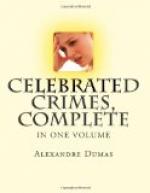“A packet has been found sealed in eight different places with eight different seals. On this is written: ’Papers to be burnt in case of my death, of no consequence to anyone. I humbly beg those into whose hands they may fall to burn them. I give this as a charge upon their conscience; all without opening the packet.’ In this packet we find two parcels of sublimate.
“Item, another packet sealed with six different seals, on which is a similar inscription, in which is found more sublimate, half a pound in weight.
“Item, another packet sealed with six different seals, on which is a similar inscription, in which are found three parcels, one containing half an ounce of sublimate, the second 2 1/4 ozs. of Roman vitriol, and the third some calcined prepared vitriol. In the box was found a large square phial, one pint in capacity, full of a clear liquid, which was looked at by M. Moreau, the doctor; he, however, could not tell its nature until it was tested.
“Item, another phial, with half a pint of clear liquid with a white sediment, about which Moreau said the same thing as before.
“Item, a small earthenware pot containing two or three lumps of prepared opium.
“Item, a folded paper containing two drachms of corrosive sublimate powdered.
“Next, a little box containing a sort of stone known as infernal stone.
“Next, a paper containing one ounce of opium.
“Next, a piece of pure antimony weighing three ounces.
“Next, a packet of powder on which was written: ’To check the flow of blood.’ Moreau said that it was quince flower and quince buds dried.
“Item, a pack sealed with six seals, on which was written, ’Papers to be burnt in case of death.’ In this twenty-four letters were found, said to have been written by the Marquise de Brinvilliers.
“Item, another packet sealed with six seals, on which a similar inscription was written. In this were twenty-seven pieces of paper on each of which was written: ‘Sundry curious secrets.’
“Item, another packet with six more seals, on which a similar inscription was written. In this were found seventy-five livres, addressed to different persons. Besides all these, in the box there were two bonds, one from the marquise for 30,000, and one from Penautier for 10,000 francs, their dates corresponding to the time of the deaths of M. d’Aubray and the Sieur de St. Laurent.”
The difference in the amount shows that Sainte-Croix had a tariff, and that parricide was more expensive than simple assassination. Thus in his death did Sainte-Croix bequeath the poisons to his mistress and his friend; not content with his own crimes in the past, he wished to be their accomplice in the future.
The first business of the officials was to submit the different substances to analysis, and to experiment with them on animals. The report follows of Guy Simon, an apothecary, who was charged to undertake the analysis and the experiments:




